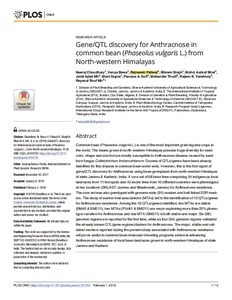| dc.contributor.author | Choudhary, N. |
| dc.contributor.author | Bawa, V. |
| dc.contributor.author | Paliwal, R. |
| dc.contributor.author | Singh, B. |
| dc.contributor.author | Bhat, M.A. |
| dc.contributor.author | Mir, J.I. |
| dc.contributor.author | Gupta, M. |
| dc.contributor.author | Sofi, P.A. |
| dc.contributor.author | Thudi, M. |
| dc.contributor.author | Varshney, Rajeev |
| dc.contributor.author | Mir, R.R. |
| dc.date.accessioned | 2019-12-04T11:21:45Z |
| dc.date.available | 2019-12-04T11:21:45Z |
| dc.date.issued | 2018-02-01 |
| dc.identifier.citation | Choudhary, N., Bawa, V., Paliwal, R., Singh, B., Bhat, M.A., Mir, J.I., ... & Mir, R.R. (2018). Gene/QTL discovery for Anthracnose in common bean (Phaseolus vulgaris L.) from north-western Himalayas. PLoS ONE 13(2), 1-12. |
| dc.identifier.issn | 1932-6203 |
| dc.identifier.uri | https://hdl.handle.net/20.500.12478/3866 |
| dc.description | Open Access Journal |
| dc.description.abstract | Common bean (Phaseolus vulgaris L.) is one of the most important grain legume crops in the world. The beans grown in north-western Himalayas possess huge diversity for seed color, shape and size but are mostly susceptible to Anthracnose disease caused by seed born fungus Colletotrichum lindemuthianum. Dozens of QTLs/genes have been already identified for this disease in common bean world-wide. However, this is the first report of gene/QTL discovery for Anthracnose using bean germplasm from north-western Himalayas of state Jammu & Kashmir, India. A core set of 96 bean lines comprising 54 indigenous local landraces from 11 hot-spots and 42 exotic lines from 10 different countries were phenotyped at two locations (SKUAST-Jammu and Bhaderwah, Jammu) for Anthracnose resistance. The core set was also genotyped with genome-wide (91) random and trait linked SSR markers. The study of marker-trait associations (MTAs) led to the identification of 10 QTLs/genes for Anthracnose resistance. Among the 10 QTLs/genes identified, two MTAs are stable (BM45 & BM211), two MTAs (PVctt1 & BM211) are major explaining more than 20% phenotypic variation for Anthracnose and one MTA (BM211) is both stable and major. Six (06) genomic regions are reported for the first time, while as four (04) genomic regions validated the already known QTL/gene regions/clusters for Anthracnose. The major, stable and validated markers reported during the present study associated with Anthracnose resistance will prove useful in common bean molecular breeding programs aimed at enhancing Anthracnose resistance of local bean landraces grown in north-western Himalayas of state Jammu and Kashmir. |
| dc.description.sponsorship | Science and Engineering Research Board, India |
| dc.format.extent | 1-12 |
| dc.language.iso | en |
| dc.subject | Common Beans |
| dc.subject | Productivity |
| dc.subject | Seedlings |
| dc.subject | Grain Legumes |
| dc.subject | Qtl |
| dc.subject | Genotypes |
| dc.title | Gene/QTL discovery for Anthracnose in common bean (Phaseolus vulgaris L.) from north-western Himalayas |
| dc.type | Journal Article |
| dc.description.version | Peer Review |
| cg.contributor.crp | Grain Legumes |
| cg.contributor.affiliation | Sher-e-Kashmir University of Agricultural Sciences & Technology of Jammu |
| cg.contributor.affiliation | International Institute of Tropical Agriculture |
| cg.contributor.affiliation | Central Institute of Temperate Horticulture, India |
| cg.contributor.affiliation | International Crops Research Institute for the Semi-Arid Tropics |
| cg.coverage.region | Asia |
| cg.coverage.region | Southeast Asia |
| cg.coverage.country | India |
| cg.creator.identifier | Bal Ram Singh: 0000-0002-5864-5157 |
| cg.researchtheme | BIOTECH & PLANT BREEDING |
| cg.isijournal | ISI Journal |
| cg.authorship.types | CGIAR and developing country institute |
| cg.iitasubject | Disease Control |
| cg.iitasubject | Grain Legumes |
| cg.iitasubject | Plant Breeding |
| cg.iitasubject | Plant Diseases |
| cg.iitasubject | Plant Genetic Resources |
| cg.journal | PloS ONE |
| cg.howpublished | Formally Published |
| cg.accessibilitystatus | Open Access |
| local.dspaceid | 96715 |
| cg.targetaudience | Scientists |
| cg.identifier.doi | https://dx.doi.org/10.1371/journal.pone.0191700 |

